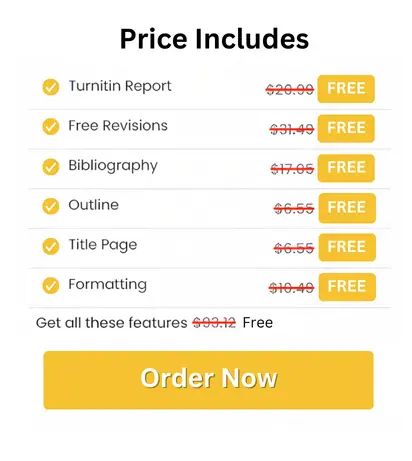
ICT101 Discrete Mathematics Report 3 Sample
Assessment Details
Purpose of the assessment: To develop a plan for a real-world example of an application in information technology from the one of the topics given below. This assessment contributes to the various learning outcomes of your Bachelor of IT degree.
Task
In the initial part of assignment, the group of students’ will be tested on their skills on writing literature review of a topic you have learnt in the Discrete Mathematics (ICT101) course in the week 1 to 6. Students need to read at least 3 articles or books on this topic especially with application to Information Technology and give detail review of those. Student will also identify one application of information Technology related to the topic in which he/she is interested and write a complete account of that interest.
Student can use the following database to find article or books.
o EBSCO Databases
o Emerald Insight
o IBISWorld
o IGI Global
o ProQuest eBooks
o O’Reilly Learning
Student group will be exploring and analysis the application of information technology related to the topic which are identified by each group member, and they must recognise an application that can be programmed into computer. Each group must sketch a plane to draw a flow-chart and algorithm. Use some inputs to test the algorithm (Give different trace table for each input) and identify any problem in the algorithm. Suggest a plane to rectify or explain why it can’t be rectified. Each group must write one report on its findings.
The topic student group can choose from are:
• Number system used in Computing
• Logic in computing
• Inverse Function in Computing
• Induction Proof and its computing application
• 16-bit Representation
The written report must have the following sections:
1. Introduction
2. Proper reference of at least three articles or books
3. Write detail review of those articles or books related to the topic student chooses
4. Identify one application in Information Technology in which student is interested.Write a complete account of that interest
5. Description of why students choose this application
6. Give a complete plane to implement the application into a computer program with use of flow-chart
7. Write an appropriate algorithm
8. Use at least two inputs to test the algorithm. Group need to give a trace table for each input.
9. Conclusion
10. Short statement about contributions/Reflections from each group member
11. References
The report must be:
1. Word or pdf document (3 to 4 pages long)
2. Size: A4
3. Use Assignment Cover Page (download from Moodle) with your details and signature
4. Single space
5. Font: Calibri, 11pt
Solution
Introduction
All digital computing systems are rooted on logic as the fundamental principle. Since computer technology, from low-level circuitry down to highly complex artificial intelligence, are mainly based on logical operation of a machine, the area of logical reasoning is inarguably applicable to all features of a computer system. This essay has three points: the logical view in computer science, one of them is artificial intelligence (AI) through the machine learning use. It includes an historical background, a theoretical frame of reference on the other scholars, a practical works as well as an use in [Computer]Information Science (IT) subject.
Review of "Digital Design" by M. Morris Mano
The textbook titled "Digital design" by M. Morris Mano is crucial to have if one wants to understand and the branch of Logic in Computing. Being concise while not using complex terminologies like binary arithmetic basics, Boolean algebra fundamentals and various other things like logic gates which is essential for having a basic idea of how one can produce data using computers for university assignment help.
Along with this, combinational and sequential circuits topic of the book which serves as the base for understanding how digital systems convey information and act on it. It has a calculation performance which will affect the device in its design and development such as processors, input and output devices, memory devices.
In addition to that, "Digital Design" covers theoretical propositions with the examples of actual performance which are applied in our daily lives. The author seeks to achieve this objective through numerous illustrations and practices so that the proposed process becomes as smooth as possible.
Through this book, the author became obligatory reading for so people who wanted to understand how data flow in computer network devices. The directness with which it exposits the problems, clarity in definition and the realness of the visualizations available in the pages provide an indispensable source used by students, instructors and practitioners plunging deeply into digital logic or using it in artificial systems.
Review of "Introduction to the Theory of Computation" by Michael Sipser
We can get now clear about the significance of logic on computing through the Automata theory, Formal languages and Computational complexity which this book deals with. The other thing that can be acquired from the Sipser text is how formal logic works behind the traditional computation and problem-solving techniques.
Underrepresentation of topic related to symbolic finite automata, regular expression, context free grammar and Turing machines helps one understand the logic.
Furthermore, it deals with the connections between logic and computational complexity discussing about the hypotheses such as triviality, undecidability and NP completeness. These topics concentrate and illustrate to what extent the importance of the logic in understanding what with the computers only can reach, and what they are not.
Though 'Introduction to the Theory of Computation' does not go deep as other textbooks do in digital logic design; but how the logic-based computers are an instrument, why computation is facilitated by logic is informative to the reader interested in understanding the foundation of computers as machine.
Review of "Artificial Intelligence: A Modern Approach" by Stuart Russell and Peter Norvig
It is considered a monumental work that provides a comprehensive report on motivation and theory for artificial intelligence (AI). Such work installs an introduction to the methods and the fields AI methods are applied to. The book basically reflects a type of AI that is also concerned with the validity of knowledge in computer science.
The authors display different mathematics-supported formal techniques to the public, such as propositional logic, first-order logic, and predicate calculus, which are essential due to their role in knowledge and reasoning between human and artificial intelligence. These logical formalisms serve as a strong tool, through which one can express rules, limits and laws of interaction between intelligent agents who perform tasks like automated reasoning, actions planning and decision making.
Moreover, the book takes different advanced logic-based AI topics on line; logical inference techniques; representation languages of knowledge such as Prolog; expert systems; natural language processing and so on. Steven and Norvig characterizes the straightforward teaching with illustrative examples to show that reasoning and problem-solving have a unique base in powerful intelligent systems. Thus, the volume under consideration unfolds the complete picture of what is the role of logic computation, as well as other fields of AI, in the research and improvement of AI. Therefore, it is the essential one for students engaged in machine learning courses as it provides practical examples which can be used in solving related problems
Overall, Artificial Intelligence: Those of an ancient origin instead look for the entire picture and the role logics play as linked to AI and research as well as development of it. This book provides only fully logical relations with their applications; therefore, it is a must-read to all those who are interested on the hybrid intersection between logic and artificial intelligence either seen from the perspective of an academic or practice eye.
Application of “Logic in Computing” in Information Technology
In Digital Circuit Design one employs Logic in Computing in many ways. The this more than one form is development of arithmetic logic units (ALUs). ALUs are the basic creating blocks that constitute modern computer processors and therefore they are chiefly responsible for any numeric or logical operation encoded as binary data. In the following part, the design of ALUs will be revealed with different logic gates including AND,OR, XOR, NOT
As for the part of ALU design, AND, OR, XOR and NOT gates are among some of the commonly utilized logic gates to perform arithmetic and logical operations. These gateways take energy 0 or 1 as per previous preset rules on which they act and produce subsequent result as it serves.
For instance, the same logic gates incorporated into these components can carry out binary addition and subtraction operations in ALUs. The full adder is a conglomeration of cohesive submission units that function as an addition of two numbers with a carry-on from the previous operation. Besides, formation of the composite multi-input gate arithmetic operations like compare, XOR, and OR among others shall be made possible with the help of those basic building blocks.
Besides, ALUs involve the usage of multiplexers, decoders and flip-flops to regulate control signals and dead flow of data across the decoder. These types of additions help a lot in completing different essential points about offering data line; changing paths; saving state of particular ALU and other like that to increase the capacity and versa ability of processing unit.
Flow chart
This flowchart outlines the sequential steps of the program: This flowchart outlines the sequential steps of the program:
Start: Its execution on the host begins.
Input Binary A and Input Binary B: The inputs are received as two binary TRUE or FALSE.
Perform AND Operation: Here, the ALU does the AND operation on 2 inputs.
Output Result of AND Operation: The Universe of Discourse and Program logic shows the next line to be executed.
Perform OR Operation: The software takes part in (Clacks) with an OR operation on two inputs.
Output Result of OR Operation: This is where we see the OR operation result. End: The program terminates.
Algorithm and testing of AND, OR Gate algorithm
.png)
Conclusion
The choosing of logic as the next digital circuit design technique—specifically, as a way of realizing arithmetic logic functions—highlights the significant contribution logic makes to further raising the processor speed and suppleness. ALUs are the most fundamental component on which digital system’s computation are bases. Using logical concepts and gate-level implementations, ALUs have made significant impacts not just on computing technology and applications but also to other fields.
Contributions/Reflections
Each group member having their say immensely helped us in carrying our investigation out, analysing the data, and writing the report that was filled with diversified viewpoints. Through the synthesis of different contributions, we have managed to create a detailed overview which encompasses the logic of computing and its applications both in general and specific terms.
References:
Mano, M. and Ciletti, M. (2018) Digital Design, Global Edition. 6th edition. Pearson Publication.
Sipser, M. (2013), Introduction to the Theory of Computation, Course Technology, Boston, MA
Russell, S. & Norvig, P. (2010), Artificial Intelligence: A Modern Approach, Prentice Hall
Would you like to schedule a callback?
Send us a message and we will get back to you
Main Services
- Accounting Assignment Help
- Accounting Assignment Helper
- Accounting Case Study Assignment Help
- Accounting Essay Help
- Assignment Help Adelaide
- Assignment Help Auckland
- Assignment Help Ballarat
- Assignment Help Bendigo
- Assignment Help Birmingham
- Assignment Help Brisbane
- Assignment Help Bristol
- Assignment Help Calgary
- Assignment Help Canberra
- Assignment Help Darwin
- Assignment Help Dubai
- Assignment Help Dublin
- Assignment Help Geelong
- Assignment Help Gold Coast
- Assignment Help Griffith
- Assignment Help Hamilton
- Assignment Help Hobart
- Assignment Help Liverpool
- Assignment Help London
- Assignment Help Manchester
- Assignment Help New York
- Assignment Help Newcastle
- Assignment Help Oxford
- Assignment Help Perth
- Assignment Help Sydney
- Assignment Help Toowoomba
- Assignment Help Toronto
- Assignment Help Wellington
- Assignment Writing Help
- AU
- Auditing Assignment Help
- Biology Assignment Help
- Bond University Assignment Help
- Business Accounting Assignment Help
- Buy Research Paper
- CA
- Case Study Help
- Corporate Accounting Assignment Help
- Cost Accounting Assignment Help
- Coursework Writing Help
- Curtin University Assignment Help
- Deakin University Assignment Help
- Dissertation Writing Help
- Do My Accounting Assignment
- Do My Accounting Papers
- Do My Finance Assignment
- Economics Assignment Help
- Engineering Assignment Help
- Essay Writing Help
- Federation University Assignment Help
- Finance Assignment Help
- Financial Planning Assignment Help
- Flinders University Assignment Help
- Holmes Institute Assignment Help
- Humanities Assignment Help
- IT Assignment Help
- JCU Assignment Help
- Kaplan Business School Assignment Help
- La Trobe University Assignment Help
- Law Assignment Help
- Leader Institute Assignment Help
- Management Assignment Help
- Managerial Accounting Assignment Help
- Mathematics Assignment Help
- Monash University Assignment Help
- MY
- Nursing Assignment Help
- NZ
- PIA University Assignment Help
- Programming Assignment Help
- Queensland University of Technology Assignment Hel
- Research Paper Help
- Research Paper Writers
- Research Paper Writing Help
- Research Paper Writing Service
- RMIT University Assignment Help
- Science Assignment Help
- SG
- Swinburne University of Technology Assignment Help
- Thesis Writing Help
- UAE
- UK
- UNSW Assignment Help
- US
- Victoria University Assessment Help
- VIT University Assignment Help
- Write My Assignment
- Write My Research Paper
Highlights
Earn While You Learn With Us
Confidentiality Agreement
Money Back Guarantee
Live Expert Sessions
550+ Ph.D Experts
21 Step Quality Check
100% Quality
24*7 Live Help
On Time Delivery
Plagiarism-Free
Our Samples
- OPS909 Total Quality Management Report 1 Sample
- HDW204 Healthcare in the Digital World Report 1 Sample
- COU101 Theories of Counselling Essay Sample
- MGT604 Strategic Management Report 3 Sample
- PBHL20001 Understanding Public Health Essay 3 Sample
- NURBN2022 Case Study 3 Sample
- DATA4700 Digital Marketing and Competitive Advantage Report 3 Sample
- MGT502 Business Communication Report 2 Sample
- ECX2953/ECX5953 Economics Essay Sample
- MITS6002 Business Analytics Research Report Sample
- DATA4000 Introduction to Business Analytics Case Study 1 Sample
- COIT20253 Business Intelligence using Big Data Report Sample
- MGT607 Innovation, Creativity & Entrepreneurship Case Study Assignment Sample
- BUMKT5902 Marketing Mix Strategy Report Sample
- MBA6204 Managing the Quantitative Support of Decision Making Report 2 Sample
- MIS605 Systems Analysis and Design Report 2 Sample
- Social Media Audit Details Report Sample
- OPS802 Operations Management Report 3 Sample
- MBA623 Healthcare Management PPT Sample
- COIT20249 Professional Skills in Information Communication Technology Report 2 Sample
- MCR001 Economics Case Study Sample
- MBA404 Consumer Behaviour and Marketing Psychology Report 1 Sample
- MBA6104 Business Process Modelling & Management Report Sample
- CAS101 Community Development Report 2 Sample
- ENEG28001 Australian Engineering Practice Report 1 Sample
- STAT2009 Statistics for Managerial Decision Assignment Sample
- DATA4400 Data-driven Decision Making and Forecasting Report 3 Sample
- AC400 Agribusiness Accounting Report 2 Sample
- INFS2036 Business Intelligence Report 1 Sample
- MGT600 Management People and Teams Report 1 Sample
- TCHR5003 Principles and Practices in Early Childhood Education Assignment Sample
- MIS603 Microservices Architecture Case Study Sample
- PUBH6008 Capstone A Applied Research Project in Public Health Report 2 Sample
- MBA600 Capstone Strategy Essay 3 Sample
- BULAW5916 Taxation Law and Practice Assignment Sample
- ENEG11005 Introduction To Contemporary Engineering Report Sample
- MN7002 International Business Strategy Report Sample
- Management Essay Sample
- MITS5003 Wireless Networks and Communication Case Study Sample
- PRJ5001 Project Management Profession Report Sample
- BUS101 Business Communication Essay 3 Sample
- Business Management Report Sample
- COIT20253 Business Intelligence using Big Data Report 1 Sample
- MECO6912 Political Public Relations Report 1 Sample
- ACCT6007 Financial Accounting Theory and Practice Report 2 Sample
- Economics for Business Assignment Sample
- Local Government Area LGA Essay 2 Sample
- BUACC5931 Research and Statistical Methods for Business Assignment Sample
- TECH2200 IT Project Management Case Study Sample
- PRJ5001 Project Management Profession Case Study 3 Sample
- Journal of Co-operative Organization and Management Sample
- HCT343 Research Methods and Data Analysis Report Sample
- Rich Picture CATWOE and Root Definition Report Sample
- OPS802 Operations Management of Subway Research Report 4 Sample
- MBIS4008 Business Process Management Report Sample
- MBA401 People, Culture and Contemporary Leadership Report 3 Sample
- ICT5151 Data and Information Management Report 4 Sample
- HI6008 Business Research Project Report Sample
- MIS607 Cybersecurity Report 3 Sample
- MGT610 Organisational Best Practice Case Study 2 Sample
- NURS2021 Dimensions of Physical and Mental Health Case Study 3 Sample
- HCCSSD104 Lifespan Development Report 3 Sample
- Information Security Assignment Sample
- MIS608 Agile Project Management Report 4 Sample
- HI5017 Managerial Accounting Report Sample
- MANM376 International Finance Project Report Sample
- BE489 Analysing Organizations in the International Report Sample
- Organisational Behaviour (OB) Essay Sample
- MIS100 Information Systems Case Study 2 Sample
- HCCSSD102 Person Centred Practice Report 1 Sample
- MBA6201 Quality Management Essay Sample
- TECH4100 UX and Design Thinking Report 2 Sample
- MBA404 Consumer Behaviour and Marketing Psychology Report Sample
- NUR2023 Pathophysiology, Pharmacology, and Nursing Management Case Study 2 Sample
- BIZ102 Understanding People and Organisations Report 3 Sample
- ACC4001 Accounting Principles and Practices Assignment Sample
- SBM3204 Sustainability and Ethics Case Study Sample
- BIZZ201 Accounting for Decision Making Report Sample
- CHM108 Introduction to Business Law Report 1 Sample
- TECH1300 Information Systems in Business Case Study 2 Sample
- CS4417 Software Security Report Sample
- MCR006 Financial Management Assignment 3 Sample
- TECH8000 IT Capstone Report Sample
- DATA4000 Introduction to Business Analytics Report 2 Sample
- OB223 Organisational Behaviour Report Sample
- BIS3006 IS Capstone Industry Project B Report Sample
- MIS611 Information Systems Capstone 3 A Report Sample
- DHI401 Digital Health and Informatics Report 2 Sample
- ETCH304 Diverse Literacy and Numeracy Learners Report 1 Sample
- Information Security PG Assignment Sample
- AHS205 The Australian Healthcare System within a Global Context Report 2 Sample
- MBIS5010 Professional Practice in Information Systems Case Study 3 Sample
- MKTG6002 Marketing Report 3 Sample
- PRJ5106 Research Methodology and Data Analysis Report 4 Sample
- 6006MHR Project Management Report Sample
- MGT605 Business Capstone Project Report 1 Sample
- MBA6302 Integrated Marketing Communications Report Sample
- ICC104 Introduction to Cloud Computing Report 3 Sample
- TECH2400 Introduction to Cyber Security Report 2 Sample
- PSYC2017 Personality and Individual Differences Research Report Sample
- PRJ5108 Project Delivery and Procurement Case Study 4 Sample
- ECUR302 Mathematics in the Early Years Report Sample
- NURBN2026 Person Centered Nursing Sample
- EASC2702 Global Climate Change Report Sample
- NURBN1012 Legal & Ethical Decision Making in Person Centred Care Sample
- Clinical Governance Essay 1 Sample
- MITS5502 Developing Enterprise Systems Report Sample
- CAP203 Care of The Person With An Acute Illness Report 4 Sample
- ACCT6006 Auditing Theory and Practice Case Study Sample
- TCHR3001 Early Childhood Matters Report 2 Sample
- DATA6000 Capstone: Industry Case Studies Report Sample
- MBA404 Consumer Behaviour and Marketing Psychology Report 3 Sample
- MBA5004 Managing Decision Making Process Report 2 Sample
- TECH2100 Introduction to Information Networks Report 3 Sample
- MIS604 Requirements Engineering Case Study 1 Sample
- PUBH1425 Life History and Determinants of Health Report Sample
- BUS5003 Information Systems and Data Analysis Case Study 2 Sample
- MANM399 International Accounting and Finance Project Report Sample
- OMGT2327 Distribution and Freight Logistics Case Study 1 Sample
- MBA5008 Business Research Methods Case Study 3 Sample
- PRJ6001 Applied Project Report 1 Sample
- MGT602 Business Decision Analytics Report Sample
- TECH1400 Database Design and Management Case Study Sample
- BUS2003 Data Engineering & Python Report 1 Sample
- OPS928 Logistics Systems Assignment Sample
- MIS500 Foundations of Information Systems Report Sample
- PPMP20009 Control Charts and Process Mapping Assignment Sample
- TECH5300 Bitcoin Report 2 Sample
- MBA602 Small Business Administration Case Study 2 Sample
- MIS608 Agile Project Management Report 2 Sample
- BUS6302 Integrated Marketing Communications Report 1 Sample
- MBA504 Introduction to Data Analytics for Business Case Study 2 Sample
- Australian Migration Law Assignment Sample
- CCB102 Multimedia Design Report 1 Sample
- EDU10005 Indigenous Education and Perspectives Essay 2 Sample
- NURBN3031 Teaching, Learning and Situational Leadership for Health Practice Sample
- EMS5RCE Risk Engineering Report 2 Sample
- PSYC20042 Psychology, Wellbeing, and Resilience Website Blog Report 2 Sample
- MOB6110 Creating Entrepreneurial Leaders Report Sample
- EDU30059 Teaching Technologies Report 2 Sample
- ECON7200 Economic Principles Report Sample
- LAW6001 Taxation Law Case Study Sample
- BPM Final Assignment Sample
- MIS608 Agile Project Management Case Study 3 Sample
- Finance Mini Case Study Sample
- ICT504 IT Project Management Report 2 Sample
- MBA6204 Quantitative Support of Decision Making Report 3 Sample
- DSMG29001 Disaster Risk Reduction Report Sample
- CAP203 Care of the person with an acute illness Case Study 2 Sample
- DATA4000 Introduction to Business Analytics Report 3
- MGT502 Business Communication Report 1B Sample
- MGT601 Dynamic Leadership Report 1 Sample
- GAL613 Grief and Loss Essay Sample
- MGT607 Innovation Creativity Entrepreneurship Case Study Sample
- MBA613 Organisational Change and Innovation Case Study 3 Sample
- OPS909 Total Quality Management Report Sample
- MOB6110 Creating Entrepreneurial Leaders Report Sample
- CA7013 Sustatnability in Global Companies 2022-23 Report
- Enem28001 fea for engineering design report sample
- Personal Improvement Plan Report Sample
- MBA6301 Event Management Report 3 Sample
- MCR007 Understanding Project Management Essay 1 Sample
- MBA622 Comprehensive Healthcare Strategies Report 1 Sample
- MBA6103 Agile Methodology Research Report 2 Sample
- BM303 Contemporary Issues in Agribusiness Production and Management Case Study Sample
- BUS2008 Strategic Planning Report Sample
- DATA4600 Business Analytics Project Management Case Study 1 Sample
- Journal Article Review Report 4 Sample
- BE969 Research Methods in Management and Marketing Sample
- FIN600 Financial Management Case Study Sample
- SITHCC001 Use Food Preparation Equipment Assignment 2 Sample
- PRJ5106 Research Methodology and Data Analysis Assignment 2 Sample
- MIS602 Data Modelling and Database Design Report 1 Sample
- TECH8000 IT Capstone Report 1 Sample
- MBA642 Project Initiation, Planning and Execution Report Sample
- BSBPMG535 Manage Project Information and Communication Business Documents Diploma Sample
- BUS5VA Visual Analytics Report 3 Sample
- DATA6000 Capstone Industry Case Studies Sample
- TO5103 Global Destination Competitiveness Report Sample
- MIS500 Foundations of Information Systems Report 1 Sample
- TECH2300 Service and Operations Management in IT Report 3 Sample
- ENGR8931 Geotechnical Engineering GE 1st Copy Sample
- EDU20014 Social and Emotional Learning Report Sample
- ICC104 Introduction to Cloud Computing Report 2 Sample
- M20467 Strategic Management Coursework Sample
- MGT502 Business Communication Report 1A Sample
- NURBN3030 Management of Deteriorating Patient Report Sample
- MBA6001 Investment Management Report 2 Sample
- MBA633 Real-world Business Analytics and Management Case Study Sample
- HEAL5004 Strategic and Operational Health Services Management Report 3 Sample
- INT103 Human Development Across the Lifespan Report 2 Sample
- MBA6204 Quantitative Support of Decision Making Report 2 Sample
- ISYS1005 Systems Analysis and Design Report 3 Sample
- EDU20014 Social and Emotional Learning Report Sample
- MIS603 Microservices Architecture Report 3 Sample
- ES5702 Planetary Health and Climate Change Report Sample
- BLCN29001 Construction Technology Report Sample
- MIS609 Data Management and Analytics Case Study 1 Sample
- FIN311 Agricultural Accounting and Business Law Part A Report Sample
- HI6032 Leveraging IT for Business Advantage Report 1 Sample
- CCS103A Counselling and Communication Skills Report Sample
- HA3011 Accounting Report Sample
- PPMP20007 Project Management Concept Report Sample
- Group of People Holding Papers Discussing White Laptop White Background Sample
- INFS5023 Information Systems for Business Case Study Sample
- MLC707 Business Law Assignment Sample
- MN691 Research Methods and Project Design Report Sample
- Health and Social Care in Emergencies and Disasters Report 3 Sample
- MBA5008 Business Research Methods Report Sample
- ECE6003 Contemporary Issues, Social Contexts of Learning and Social Justice Sample
- DATA4000 Introduction to Business Analytics Report 3 Sample
- ENEG11005 Introduction to Contemporary Engineering Report Sample
- NURBN1016 Primary Health Essay 2 Sample
- GDECE102 Learning and Development Birth To Two Years Report 1 Sample
- CMT218 Data Visualisation Case Study Sample
- ECUR207 Early Childhood Teacher Report Sample
- MBA641 Strategic Project Management Report Sample
- DSMG29002 Leadership in Emergency and Disaster Management Report 2 Sample
- HI6034 Enterprise Information Systems Report Sample
- ICT80011/40005 Energy Storage System Report Sample
- BSBOPS601 Develop and Implement Business Plan Diploma Sample
- TO5103 Global Destination Competitiveness Report Sample
- BE485 Management and Strategy Report Sample
- BUS5PB Principles of Business Analytics Report 1 Sample
- ICT101 Discrete Mathematics Report 3 Sample
- MBIS5010 Professional Practice in Information Systems Essay 2 Sample
- EDU40002 Play and Environment Report 2 Sample
- HI5004 Marketing Management Assignment Sample
- ACC202 Contemporary Financial Accounting Report Sample
- PROJ-6012 Managing Information Systems, Technology Report Sample
- MITS6004 Enterprise Systems Report 1 Sample
- Recovery Nursing Care Plan Case Study Sample
- MBA643 Project Initiation, Planning and Execution Report Sample
- BUS102 Management Principles Essay 2 Sample
- ACC602 Financial Accounting and Reporting Report 4 Sample
- Marketing Assignment Writing Sample
- MIS611 Information Systems Capstone Report 1 Sample
- MITS5004 IT Security Research Report 2 Sample
- INT102 Assessment 1B Improving Communication with Vision-Impaired People Case Study Sample
- FINM4100 Analytics in Accounting, Finance and Economics Report 2 Sample
- MBIS4009 Professional Practice in Information Systems Essay Sample
- HCCSSD103 Mental Health Case Study 3 Sample
- Investigating The Issue of Inequality in Workplaces Essay Sample
- MITS4004 IT Networking and Communication Report Sample
- PPMP20009 Case Study Sample
- TECH3200 Artificial Intelligence and Machine Learning in IT Report 3 Sample
- BUS5DWR Data Wrangling and R Report 3 Sample
- PPMP20008 Initiating and Planning Projects Report 3 Part B Sample
- MBA402 Governance, Ethics and Sustainability Report 2 Sample
- Strategic and Operating Health Management Report 2 Sample
- SWOT Analysis of Chanel No5 Perfume Marketing 4ps Report
- MEE80003 Automation Strategy Case Study Sample
- HWEL2006 Social and Emotional Wellbeing Case Study 3 Sample
- MITS4001 Business Information Systems Case Study 3 Sample
- HDW204 Healthcare in the Digital World Report 2 Sample
- TECH2300 Service and Operations Management in IT Case Study 2 Sample
- NURBN2023 Pathophysiology and Pharmacology Applied to Person-Centred Nursing Essay Sample
- M5011 Accounting for Management Report Sample
- MGT501 Business Environment Report Sample
- Principles of Supply Chain Management Report Sample
- BAO6504 Accounting For Management Report Sample
- Planning in Health and Social Care Essay Sample
- FE7066 Data Analysis for Global Business Coursework Sample
- MBA402 Governance, Ethics and Sustainability Report 3 Sample
- DATA4400 Data-driven Decision Making and Forecasting Report 3 Sample
- MBA633 Real-world Business Analytics and Management Report 2 Sample
- ACCY801 Accounting and Financial Management Report 2 Sample
- FIT5057 Project Management Case Study 1 Sample
- MG304 Agriculture Value Chain Management Case Study 2 Sample
- MGT613 Leadership for Sustainable Futures Report Sample
- CSE2AIF/CSE4002 Artificial Intelligence Fundamentals Report Sample
- 32144 Technology Research Preparations Report 2 Sample
- DATA4900 Innovation and Creativity in Business Analytics Report 4 Sample
- MIS604 Requirement Engineering Report 1 Sample
- MBA404 Consumer Behaviour and Marketing Psychology Case Study 2 Sample
- MBA673 Business Analytics Life Cycle Report 2 Sample
- MBA503 Operations Management and Decision-Making Models Report 3 Sample
- DATA4300 Data Security and Ethics Report 1 Sample
- DATA4500 Social Media Analytics Case Study Sample
- MBA601 Fundamentals of Entrepreneurship Case Study 2 Sample
- MIS608 Agile Project Management Report 1 Sample
- Critically Examine and Identify the Issues within The Case Study from a Legal and Ethical Perspectiv
- ADM80001 Nanofabrication Technologies Report Sample
- MBA600 Capstone Strategy Report 2 Sample
- OPS928 Logistics Systems Report 2 Sample
- AT3 Nursing Case Study Sample
- OPS928 Logistics Systems Assignment Sample
- CAO107 Computer Architecture & Operating Systems Report 2 Sample
- COIT20248 Information Systems Analysis & Design Report 1 Sample
- BULAW5915 Corporate Law Assignment Sample
- M33117 Public Policies and Labour Markets Report Sample
- Child Development Case Study Sample
- ECON20039 Economics for Managers Report 2 Sample
- PROJ6000 Principles of Project Management Report Sample
- Written Assessment Report 2 Sample
- MIS610 Advanced Professional Practice Report 2 Sample
- MBIS4008 Business Process Management Report 2A Sample
- GDECE101 Early Childhood Care and Education Report Sample
- OPS910 Linear Programming Assignment Sample
- MBIS5009 Business Analytics Report Sample
- CPO442 Cybersecurity Principles and Organisational Practice Report 2 Sample
- MIS609 Data Management and Analytics Case Study 3 Sample
- MIS610 Advanced Professional Practice Report 3 Part A Sample
- MIS605 Systems Analysis and Design Assignment 1 Sample
- MN7001 Summative Assessment 2 Report Sample
- NURBN2021 Nursing Essay Sample
- PLM Principles of Logistics Management Report Sample
- TEC100 Introduction to Information Technology Report 2 Sample
- DATA4000 Introduction to Business Analytics Case Study 1 Sample
- MIS608 Agile Project Management Report 2 Sample
- PUBH6008 Capstone A Applied Research Project in Public Health Report Sample
- GDECE103 Language and Literacy in the Early Years Report 2 Sample
- EC102 Agricultural Economics Assignment Sample
- TECH2200 IT Project Management Report 2 Sample
- OPS911 Strategic Procurement Management Report Sample
- MIS610 Advanced Professional Practice Report 2 Sample
- MIS605 Systems Analysis and Design Report Sample
- Principles of Economics Assignment Sample
- MBA504 Introduction to Data Analytics for Business Report 3 Sample
- BUECO5903 Business Economics Assignment Part B Assignment Sample
- MIS604 Requirement Engineering Report 3 Sample
- ECE6012 Professional Practice Report 1 Sample
- WPDD202 Webpage Design and Development Report 4 Sample
- TECH2400 Introduction to Cyber Security Report 1 Sample
- MBA505 Business Psychology Coaching and Mentoring Report Sample
- MBA600 Capstone Strategy Essay 3 Sample
- EC400 Agribusiness Economics and Finance Case Study 3 Sample
- BST714 Strategic and Operational Decision-Making Assignment Sample
- MEM601 Engineering Sustainability Report Sample
- HI5031 Professional Issues in IS Ethics and Practice Case Study Sample
- DSMG2002 Exploring Emergency in Disaster Management Research Report 1 Sample
- CWB103 Interpersonal and Intercultural Negotiation Assessment 1 Sample
- MIS775 Decision Modelling for Business Analytics Report Sample
- MBIS5012 Strategic Information Systems Report Sample
- DATA4900 Innovation and Creativity in Business Analytics Report 3 Sample
- MBA5008 Business Research Methods Report 2 Sample
- Impact of Green Supply Chain Management on The Profitability of The Retail Industry Sample
- COIT20262 Advanced Network Security Report 2 Sample
- COIT20249 Professional Skills in Information Communication Technology Report2 Sample
- MEM603 Engineering Strategy Report 2 Sample
- MGNT803 Organisational Behaviuor and Management Report Sample
- MG301 Agriculture and Resource Policy Case Study Sample
- ACCM4400 Auditing and Assurance Report Sample
- HI5029 IS Project Management Report Sample
- MBA402 Governance, Ethics and Sustainability Report 3 Sample
- MGT602 Business Decision Analytics Report 3 Sample
- MBA401 People, Culture and Contemporary Leadership Report Sample
- TUM202 Therapeutic use of Medicines Report 2 Sample
- MC7080 Digital Marketing & Social Media Report Sample
- TECH2100 Introduction to Information Networks Report 2 Sample
- TECH2200 IT Project Management Case Study 1 Sample
- COIT20252 Business Process Management Report 3 Sample
- BRM5002 Intercultural Awarness for Business Report Sample
- ACF5956 Advanced Financial Accounting Report Sample
- INT101 Introduction to International Relations and Politics Essay Sample
- MBA501 Dynamic Strategy and Disruptive Innovation Case Study 1 Sample
- MBA504 Introduction to Data Analytics for Business Case Study 1 Sample
- ICT606 Machine Learning Report Sample




 81 Isla Avenue Glenroy, Mel, VIC, 3046 AU
81 Isla Avenue Glenroy, Mel, VIC, 3046 AU



